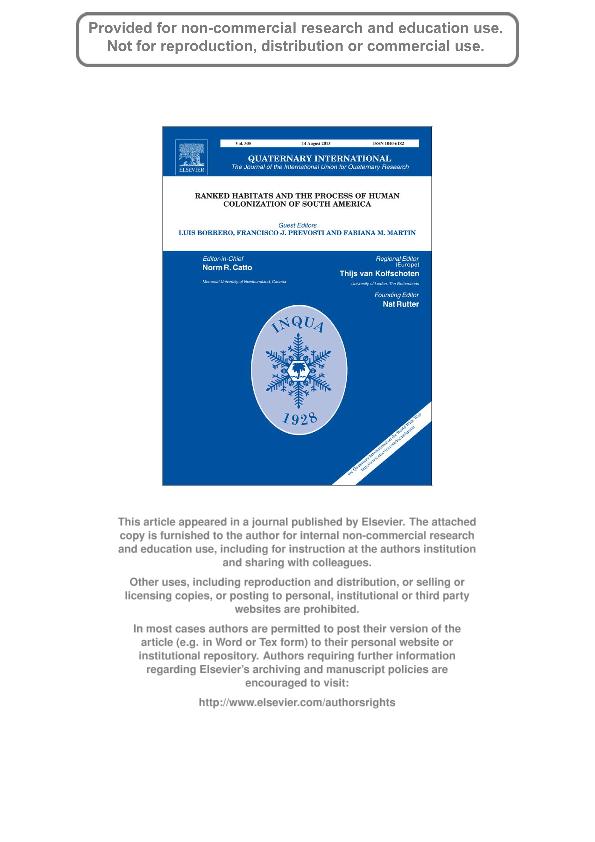Mostrar el registro sencillo del ítem
dc.contributor.author
Pardiñas, Ulyses Francisco J.

dc.contributor.author
Teta, Pablo Vicente

dc.date.available
2016-04-20T20:51:03Z
dc.date.issued
2013-08
dc.identifier.citation
Pardiñas, Ulyses Francisco J.; Teta, Pablo Vicente; Holocene stability and recent dramatic changes in micromammalian communities of northwestern Patagonia; Elsevier; Quaternary International; 305; 8-2013; 127-140
dc.identifier.issn
1040-6182
dc.identifier.uri
http://hdl.handle.net/11336/5297
dc.description.abstract
Micromammalian fossil sequences of two classical archaeological sites, Cueva Traful I (CTI) and Cueva Epullán Grande (LL), both in the province of Neuquén, northwestern Patagonia, Argentina, were studied. These sequences cover the entire Holocene, with assemblages mainly composed by rodent and marsupial remains accumulated by owls. Both sites are located near the ecotone fringes of the major vegetation units currently present in Patagonia: Forest-Patagonian steppe (CTI) and Patagonian steppe-Monte desert (LL). Comparisons between fossil and recent owl pellet samples in a regional approach indicated that micromammal communities remained stable over the major part of the last 10 ka, with some minor expansion of desert adapted taxa to the west since the middle Holocene, and a dramatic change in the assemblages during the last 100e150 years. Two alternative but not contradictory explanations can be presented to interpret the stable period. First, climate-environmental changes were not of sufficient magnitude to produce a clear reorganization of micromammal communities. Forest did not invade CTI surroundings, and Monte did not reach around LL. Second, the basic structure of northwestern Patagonian steppe micromammal communities was resilient to minor or moderate climate-environmental changes. The strong shift depicted in the studied sequences in very recent times (100e150 years) can be linked to human impact on the regional environment. This change involves a deep restructuration of small mammal communities ranging from virtual extirpations of some species to dramatic increments of opportunistic taxa. A century of sheep overgrazing, coupled with the introduction of exotic shrubs, was the main factor driving the configuration of present small mammal assemblages in northwestern Patagonia.
dc.format
application/pdf
dc.language.iso
eng
dc.publisher
Elsevier

dc.rights
info:eu-repo/semantics/openAccess
dc.rights.uri
https://creativecommons.org/licenses/by-nc-nd/2.5/ar/
dc.subject
Patagonia
dc.subject.classification
Paleontología

dc.subject.classification
Ciencias de la Tierra y relacionadas con el Medio Ambiente

dc.subject.classification
CIENCIAS NATURALES Y EXACTAS

dc.title
Holocene stability and recent dramatic changes in micromammalian communities of northwestern Patagonia
dc.type
info:eu-repo/semantics/article
dc.type
info:ar-repo/semantics/artículo
dc.type
info:eu-repo/semantics/publishedVersion
dc.date.updated
2016-05-06 15:52:43.262787-03
dc.journal.volume
305
dc.journal.pagination
127-140
dc.journal.pais
Países Bajos

dc.journal.ciudad
Amsterdam
dc.description.fil
Fil: Pardiñas, Ulyses Francisco J.. Consejo Nacional de Investigaciones Científicas y Técnicas. Centro Nacional Patagónico; Argentina
dc.description.fil
Fil: Teta, Pablo Vicente. Consejo Nacional de Investigaciones Científicas y Técnicas. Centro Nacional Patagónico; Argentina
dc.journal.title
Quaternary International

dc.relation.alternativeid
info:eu-repo/semantics/altIdentifier/url/http://www.sciencedirect.com/science/article/pii/S1040618212005307
dc.relation.alternativeid
info:eu-repo/semantics/altIdentifier/doi/10.1016/j.quaint.2012.08.001
dc.relation.alternativeid
info:eu-repo/semantics/altIdentifier/doi/http://dx.doi.org/10.1016/j.quaint.2012.08.001
Archivos asociados
